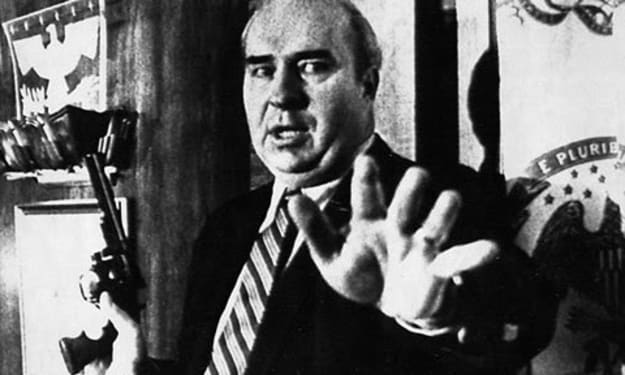64,000 Reasons Why You Should Never Doubt A Hungry Woman
From a game show contestant to the most influential pop psychologists of all time.

The early days
Joyce Diane Bauer was born on October 29, 1929, in New York City to middle-class parents, attorneys Morris K. and Estelle Bauer. She grew up in Queens, New York, with her younger sister Elaine to keep her company.
Joyce had a knack for psychology from a young age, according to her daughter, Lisa Brothers Arbisser. When Joyce was a teenager, she taught ballet to children at a local dance studio, giving them free classes for the first six months and then charging them if they signed up for more.
"She told a cliffhanger story to the kids at the end of each lesson, so at the end of six months, she had this story going that they absolutely wanted to keep hearing, and they signed up," Arbisser said. "So she was a natural psychologist from early on."
Joyce Diane Bauer enrolled at Cornell University at the age of 16, double-majoring in home economics and psychology. She would earn a B.S. degree with honors in 1947 before continuing to Columbia University, where she earned a master's degree in 1949 and a doctorate in psychology in 1953.
Somehow, between all of this studying, Joyce met Milton Brothers, a young pre-med student, and they fell in love. The two married on July 4, 1949.
By 1955, Milton Brothers was still in medical school. Dr. Joyce Brothers had recently quit her teaching jobs at Hunter College and Columbia University to stay at home with her newborn daughter, Lisa. But without the addition of Joyce's teaching wages, the young family quickly found themselves struggling to make ends meet on Milton's residency stipend of $50 per month.
Around the same time, television quiz shows were gaining popularity. Joyce hatched a bold plan to supplement their income: she would transform herself into a boxing expert and audition for "The $64,000 Question," a prominent 1950s television quiz show.
"Gee, a loser on those shows gets a Cadillac," she once recalled, "and I could be a loser."
Little did she know, she would come away with way more than a Cadillac!
The $64,000 Question
Today, with the thousands of channels available to watch, it may be difficult to understand just how influential and popular 1950s, game shows, particularly quiz shows like "The $64,000 Question," were across the U.S during that time. Movie theatres and restaurants reported low attendance on Tuesday nights when The $64,000 Question was broadcast. Crime rates and long-distance phone calls also decreased around air time.
For this particular game show, contestants answered increasingly challenging questions about a single subject for more and more elaborate prizes, up to the namesake $64,000 grand prize. To give the show a bit more spice, the producers sought out competitors with colorful personalities, who had experience in unusual fields of knowledge at the time. As such, Joyce entered claiming to be a boxing expert, an odd subject for a young female psychologist. This piqued the producers' interest, and they invited her on.
However, Joyce had no prior experience or interest in boxing, so in the weeks leading up to her appearance, she memorized 20 volumes of a boxing encyclopedia, read magazine articles, watched film reels, and studied with boxing writer Nat Fleischer and former Olympic boxing champion Edward Egan. She later explained that she was motivated by the fact that "we were hungry."
In the fall of 1955, Joyce made her television debut, and she won over the audience with her composure and expertise, quickly breezing through the questions posed to her.
But behind the scenes, things were not so breezy. For you see, the $64,000 Question was sponsored by Revlon, a cosmetics company, and Joyce did not wear make-up. This irritated Charles Revson, owner of Revlon, who told the producers, 'Get that bitch off the show,' after Joyce had reached $16,000.
At this command, the questions became increasingly complex, with all-out war being waged against Joyce. Nat Fleischer, the very same boxing writer Joyce studied with, was brought in to develop the most difficult of boxing questions to stump Dr. Joyce Brothers. The producers of the show started asking her questions about boxing referees rather than boxers. Yet, with each perplexing question, Joyce got the right answer, maintaining her popularity with the audience. She correctly answered the final question in her last appearance on the show in December 1955.
A star is born
After her 1955 T.V. debut, Joyce tried her hand once again in the game show arena. In 1957, she appeared on The $64,000 Challenge, a spin-off of The $64,000 Question, that pitted reigning champions against specialists in respective fields. She once again aced every question, netting the grand prize money.
Joyce's popularity on these game shows served as a jumping-off point for her eventual career in the entertainment industry. After appearing on the $64,000 Question and $64,000 Challenge, she cohosted Sports Showcase in 1956, in which she interviewed famous athletes and addressed sporting topics.
By 1958, Joyce decided to merge her newfound notoriety with her psychology career, aiming to use television to provide assistance and advice to a large audience.
She approached NBC about launching a television show akin to a newspaper advice column. She would read letters from viewers and assist them in working through their psychological issues. NBC management was hesitant to have Joyce discuss things like sex and abortion on the air, but they thought the concept was strong, and she launched her self-titled television show in August 1958.
The show was an instant hit, and Joyce became recognized as the first "pop psychologist." Her sympathetic demeanor and ability to discuss issues in layman's terms rather than professional jargon contributed significantly to her success. People flocked to her because she was prepared to handle any topic, no matter how delicate, much to the chagrin of the NBC censors.
Soon, Joyce found herself making approximately 100 appearances on "The Tonight Show Starring Johnny Carson" and other talk shows, establishing an image as the poised, cheery woman who always knew research-based solutions to everyone's concerns. Joyce even addressed previously taboo issues on these late-night talk shows, including menopause, frigidity, impotence, and sexual fulfillment.
And if that wasn't enough, Dr. Joyce Brothers penned magazine articles throughout her public career, wrote a syndicated newspaper column for 350 daily newspapers, and counseled various manufacturers on women's requirements. She wrote a number of books and appeared as herself in a handful of films and T.V. shows, including The Simpsons, Analyze That, The Nanny, Ally McBeal, and Entourage.
Later on in life, Brothers spoke out against sexist bias in the 1970s, arguing the need to update textbooks since youngsters quickly pick up discriminatory ideas from them. She advocated for children to learn that it's okay to be either male or female, resulting in more positive self-perceptions.
More than a decade later, tragedy struck when Milton was diagnosed with cancer in 1987, and the couple's lives were turned upside down. Despite his encouragement to continue her profession, Joyce devoted every waking moment to Milton, often neglecting herself to care for him. In January 1989, he died, leaving Joyce heartbroken.
She took a year away from the public eye and even considered suicide. She plunged herself into her writing, though, and in 1991, she released "Widowed," a memoir about Milton's death and her anguish over it. Thousands of more people called to tell their stories of loss and sadness in response to "Widowed," and Joyce took advantage of the opportunity to start a public conversation so that they could all help each other with their problems.
Dr. Joyce Brothers passed away peacefully on May 13, 2013, at the age of 85.
---
About the Creator
Chelsea Rose
I never met a problem I couldn't make worst.






Comments
There are no comments for this story
Be the first to respond and start the conversation.